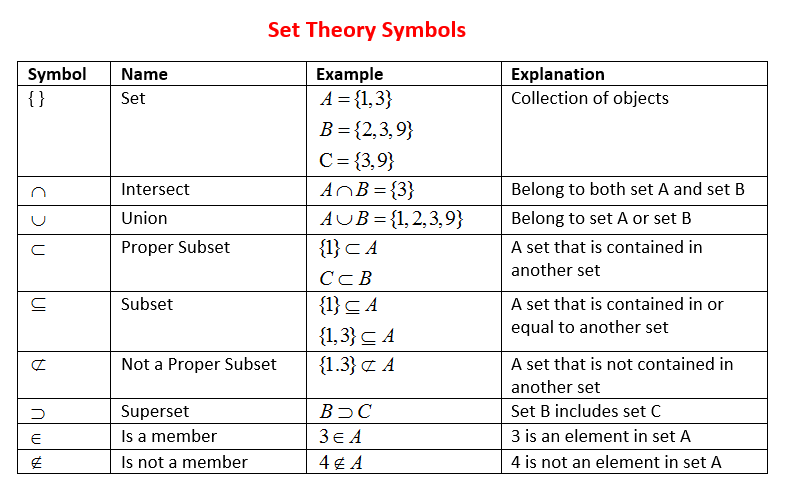Describing And Defining Sets
Related Pages
Set Operations
Venn Diagrams
More Lessons On Sets
In these lessons, we will learn
- how to define sets and set notations,
- subsets and proper subsets,
- Venn diagrams and set operations.
| Sets | ||
|---|---|---|
| Ways to Describe Sets | Subsets | Venn Diagrams |
What is a set?
A set is a collection of objects, things or symbols which are clearly defined. The individual objects in a set are called the members or elements of the set.
The following table shows some Set Theory Symbols. Scroll down the page for more examples and solutions of how to use the symbols.

A set must be properly defined so that we can find out whether an object is a member of the set.
Ways to Describe a Set
1. Listing The Elements (Roster Method)
The set can be defined by listing all its elements, separated by commas and enclosed within braces. This is called the roster method.
Examples:
V = {a, e, i, o, u}
B = {2, 4, 6, 8, 10}
X = {a, b, c, d, e}
However, in some instances, it may not be possible to list all the elements of a set. In such cases, we could define the set by methods 2 or 3.
2. Describing The Elements
The set can be defined, where possible, by describing the elements clearly in words.
Examples:
R is the set of multiples of 5.
V is the set of vowels in the English alphabet.
M is the set of months of a year.
3. Description By Set Builder Notation
The set can be defined by describing the elements using mathematical statements. This is called the set-builder notation.
Examples:
C = {x : x is an integer, x > –3 }
This is read as: “C is the set of elements x such that x is an integer greater than –3.”
D = {x: x is the capital city of a state in the USA}
We should describe a certain property which all the elements x, in a set, have in common so that we can know whether a particular thing belongs to the set.
We relate a member and a set using the symbol ∈. If an object x is an element of set A, we write x ∈ A. If an object z is not an element of set A, we write z ∉ A.
∈ denotes “is an element of’ or “is a member of” or “belongs to”
∉ denotes “is not an element of” or “is not a member of” or “does not belong to”
Example:
If A = {1, 3, 5} then 1 ∈ A and 2 ∉ A
Basic Vocabulary Used In Set Theory
A set is a collection of distinct objects. The objects can be called elements or members of the set.
A set does not list an element more than once since an element is either a member of the set or it is not.
There are three main ways to identify a set:
- A written description,
- List or Roster method,
- Set builder Notation,
The empty set or null set is the set that has no elements.
The cardinality or cardinal number of a set is the number of elements in a set.
Two sets are equivalent if they contain the same number of elements.
Two sets are equal if they contain the exact same elements although their order can be different.
Definition And Notation Used For Subsets And Proper Subsets
If every member of set A is also a member of set B, then A is a subset of B, we write A ⊆ B. We can also say A is contained in B.
If A is a subset of B, but A is not equal B then A is a proper subset of B, we write A ⊂ B.
The empty set is a subset of any set.
If a set A has n elements that it has 2n subsets.
How To Use Venn Diagrams To Show Relationship Between Sets And Set Operations?
A Venn diagram is a visual diagram that shows the relationship of sets with one another. The set of all elements being considered is called the universal set (U) and is represented by a rectangle. Subsets of the universal set are represented by ovals within the rectangle.
The complement of A, A’, is the set of elements in U that is not in A.
Sets are disjoint if they do not share any elements.
The intersection of A and B is the set of elements in both set A and set B.
The union of A and B is the set of elements in either set A or set B or both.
Examples Of Basic Venn Diagrams And Set Operations
Try out our new and fun Fraction Concoction Game.
Add and subtract fractions to make exciting fraction concoctions following a recipe. There are four levels of difficulty: Easy, medium, hard and insane. Practice the basics of fraction addition and subtraction or challenge yourself with the insane level.

We welcome your feedback, comments and questions about this site or page. Please submit your feedback or enquiries via our Feedback page.